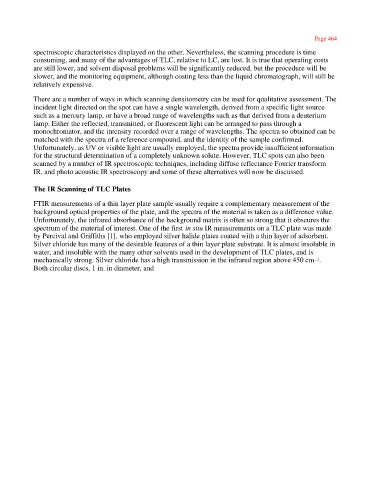Page 479 - Tandem Techniques
P. 479
Page 464
spectroscopic characteristics displayed on the other. Nevertheless, the scanning procedure is time
consuming, and many of the advantages of TLC, relative to LC, are lost. It is true that operating costs
are still lower, and solvent disposal problems will be significantly reduced, but the procedure will be
slower, and the monitoring equipment, although costing less than the liquid chromatograph, will still be
relatively expensive.
There are a number of ways in which scanning densitometry can be used for qualitative assessment. The
incident light directed on the spot can have a single wavelength, derived from a specific light source
such as a mercury lamp, or have a broad range of wavelengths such as that derived from a deuterium
lamp. Either the reflected, transmitted, or fluorescent light can be arranged to pass through a
monochromator, and the intensity recorded over a range of wavelengths. The spectra so obtained can be
matched with the spectra of a reference compound, and the identity of the sample confirmed.
Unfortunately, as UV or visible light are usually employed, the spectra provide insufficient information
for the structural determination of a completely unknown solute. However, TLC spots can also been
scanned by a number of IR spectroscopic techniques, including diffuse reflectance Fourier transform
IR, and photo acoustic IR spectroscopy and some of these alternatives will now be discussed.
The IR Scanning of TLC Plates
FTIR measurements of a thin layer plate sample usually require a complementary measurement of the
background optical properties of the plate, and the spectra of the material is taken as a difference value.
Unfortunately, the infrared absorbance of the background matrix is often so strong that it obscures the
spectrum of the material of interest. One of the first in situ IR measurements on a TLC plate was made
by Percival and Griffiths [1], who employed silver halide plates coated with a thin layer of adsorbent.
Silver chloride has many of the desirable features of a thin layer plate substrate. It is almost insoluble in
water, and insoluble with the many other solvents used in the development of TLC plates, and is
mechanically strong. Silver chloride has a high transmission in the infrared region above 450 cm- .
1
Both circular discs, 1 in. in diameter, and

